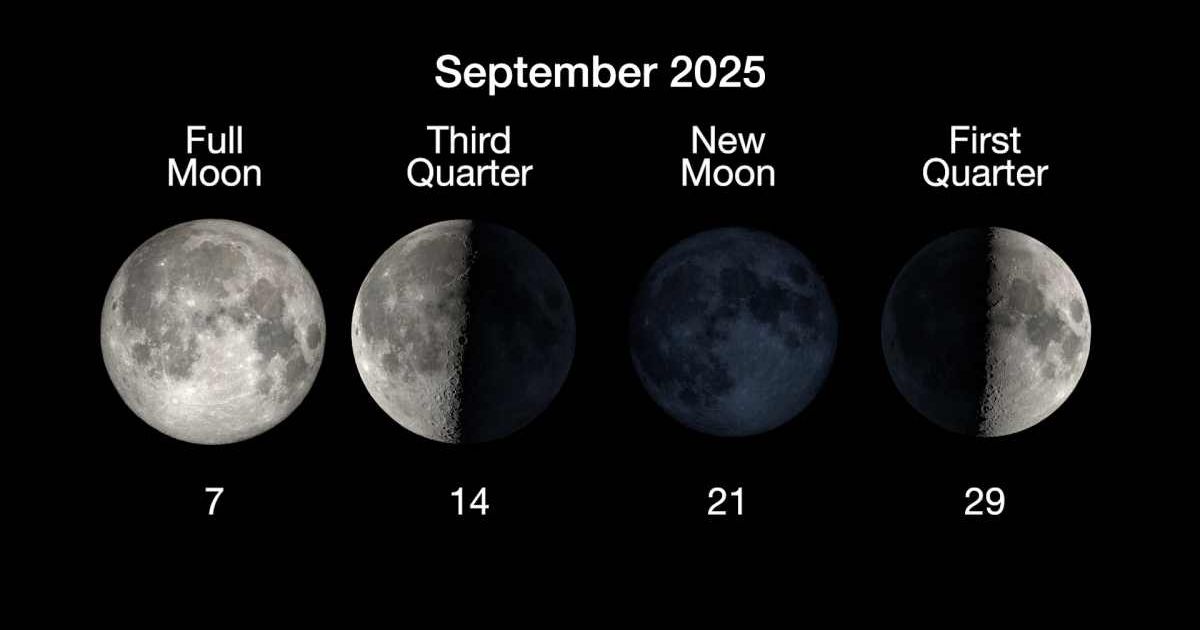Moon phases 2025: When is the next new moon

The next new moon will grace the sky on September 21, 2025, marking the start of a new lunar cycle, according to NASA. While often unobservable, the new moon is a pivotal moment in celestial mechanics and holds significance across various cultures. On this day, the distance between the moon and Earth will be 396,224 miles.

The science of the New Moon
During a new moon, the Sun and Moon are arranged in a direct line, with the Moon positioned between the Sun and Earth. This alignment, known as a conjunction, or syzygy, is the primary reason the new moon is invisible to the naked eye. The sunlit side of the Moon faces away from Earth, leaving the side we see in complete darkness. Additionally, the new moon rises and sets at roughly the same time as the Sun, making it difficult to spot against the Sun's bright glare. However, there is a notable exception: a solar eclipse. As the moon's orbit around our planet is minimally tilted, oftentimes this 'conjunction' of the three is not in a perfect line. This allows skygazers to catch a deceptively thin lunar crescent vanishing in the sky shortly after the exact moment of a New Moon's occurrence.

Tides and cultural calendars
The new moon has a significant impact on Earth's tides. The combined gravitational pull of the Sun and Moon during this phase results in exceptionally high and low tides, known as spring tides or king tides. This tidal effect is also at its peak during the full moon. Beyond its astronomical effects, the new moon holds cultural importance. Many traditional calendars, including the Islamic calendar, begin their months after the sighting of the first, thin crescent of a new moon. If sighted on the 29th of a month, then the new month begins the next day. If, due to uncontrollable reasons such as cloud coverage or storms, the thin crescent cannot be seen in the sky, then the month continues through the 30th day before a new month begins.
Understanding the lunar cycle
The new moon is the first of eight key phases that make up the lunar month. A 'new moon' is followed by an intermediate phase seen as the 'waxing crescent,' then the 'first quarter' which makes half the moon visible, then the 'waxing gibbous' which stretches its light cover further, followed by the 'full moon' when the entire moon face is lit up. Soon, it begins its return to the 'new moon' phase through 'waning gibbous,' then 'third quarter,' and finally 'waning crescent' before a 'new moon' arrives. The new moon phase is also the only time a solar eclipse can occur. This is because solar eclipses happen when the Moon passes directly between the Earth and the Sun, a geometry that is exclusive to the new moon phase. Conversely, lunar eclipses can only take place during a full moon.

Why does the Moon become invisible?
An observer on Earth cannot see the new moon because its night side is turned toward our planet, leaving its far side fully illuminated by the Sun, as per NASA. The Moon's position in the sky also makes it challenging to spot, as it travels in tandem with the Sun during the day. This absence of moonlight makes the new moon a prime time for stargazing and observing faint astronomical objects.
New Moon times across US cities
The upcoming new moon will occur on Sunday, September 21, 2025, at 19:54 UTC. For residents in the United States, this event will take place on September 21 at 3:54 ET, with time zone differences affecting its exact timing across States, per Time and Date.
Here are the specific times for several major US metropolitan areas:
| Cities | Date | Time |
| Seattle | September 21, 2025 | 12:54 PM (PDT) |
| Los Angeles | September 21, 2025 | 12:54 PM (PDT) |
| Houston | September 21, 2025 | 2:54 PM (PDT) |
| Chicago | September 21, 2025 | 2:54 PM (PDT) |
| New York | September 21, 2025 | 3:54 PM (PDT) |
Due to its elliptical path, the moon's distance from the Earth fluctuates throughout the lunar month. At its closest point (perigee), it forms a Super New Moon, and at its farthest (apogee), it forms a Micro New Moon. There will be three back-to-back Super New Moons in 2025 on October 7, November 5, and December 4.
More on Starlust
In pics: 'Blood Moon' total lunar eclipse as seen from Japan, Egypt, India and across the globe









